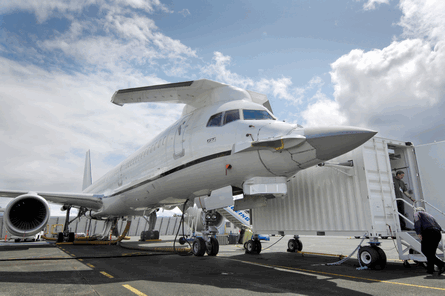Boeing on 6 June launched the next major upgrade for the US Air Force's Lockheed Martin F-22 Raptor aboard the programme's previously retired flying testbed.
The heavily modified Boeing 757, featuring a canard-mounted wing and the F-22's nose radome, has been returned from "warm storage" to test a package of upgrades called increment 3.1. The cabin includes a full mock-up of the F-22 cockpit.
Scheduled to be delivered in fiscal year 2010, the USAF's second major round of F-22 upgrades adds an electronic attack function and integrates the Boeing GBU-39 small diameter bomb. Lockheed previously added an air-to-ground mode for surveillance and attack in increment 2, which is now operational.
 |
|---|
© Boeing |
As supplier for the F-22's aft fuselage and wings and also the systems integrator, Boeing's main role in increment 3.1 is to identify and fix any software bugs and glitches that may arise in development over the next two years.
Last December, Boeing received approval to overhaul its approach to systems integration testing, bringing back the flying testbed and connecting it to a ground testing station.
Boeing's renamed agile integration laboratory (AIL), which includes the 757 and the ground laboratory, will give engineers a jump on software issues before they are installed on the USAF's flight test fleet of F-22s based at Edwards AFB, California. "If there's problems, we can jump on them months earlier than when we went to Edwards before", says Brian Harden, Boeing's AIL programme manager.
Boeing also intends to offer the 757 as a flying testbed to other customers, and is in talks with at least five other programmes about using the AIL to flight-test a variety of payloads. However, the F-22 will remain the project's main sponsor, and will always receive first billing.
Meanwhile, Boeing continues to support efforts by Lockheed and the USAF to obtain funding from Congress to buy more F-22s, despite resistance from Secretary of Defense Bob Gates, who has submitted a budget request for FY2009 that omits long-lead funding to keep production alive.
The House Armed Services Committee voted to reinsert funds for long-lead procurement, but the Senate Armed Services Committee demurred, passing a bill that delays a decision until the next administration arrives.
A new administration will not submit a budget request until February 2009, but the F-22 supply chain requires a new commitment before 31 October this year. "Without funding it will gap the production line," says Bob Jenkins, Boeing's director for F-22 business strategy.
Jenkins says the USAF sent a letter to Congress on 3 June stating that a production gap lasting months would raise F-22 production costs by at least several hundred million dollars. A one-year gap between orders could raise costs by up to $1 billion, he adds.
Source: Flight International























